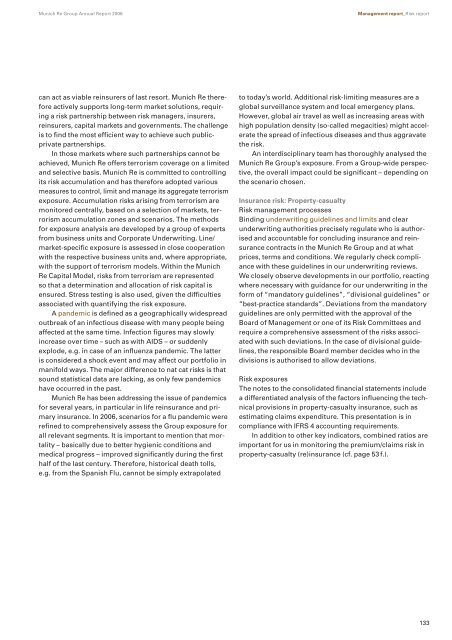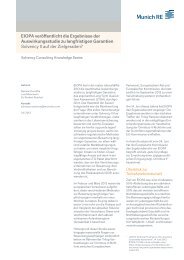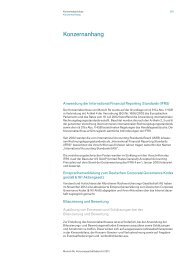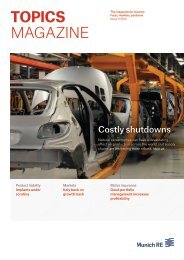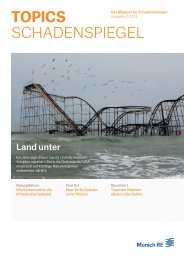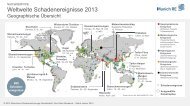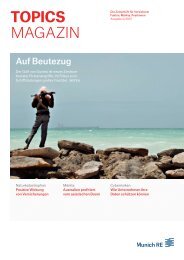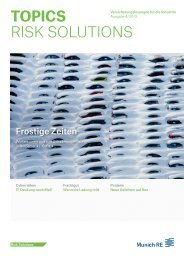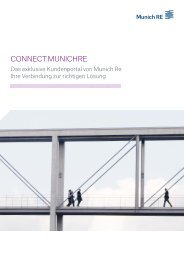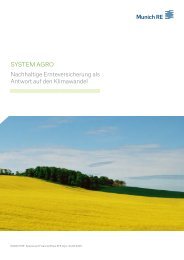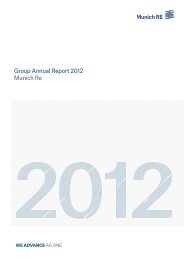Munich Re Group Annual Report 2006 (PDF, 1.8
Munich Re Group Annual Report 2006 (PDF, 1.8
Munich Re Group Annual Report 2006 (PDF, 1.8
You also want an ePaper? Increase the reach of your titles
YUMPU automatically turns print PDFs into web optimized ePapers that Google loves.
<strong>Munich</strong> <strong>Re</strong> <strong>Group</strong> <strong>Annual</strong> <strong>Re</strong>port <strong>2006</strong> Management report_Risk report<br />
can act as viable reinsurers of last resort. <strong>Munich</strong> <strong>Re</strong> therefore<br />
actively supports long-term market solutions, requiring<br />
a risk partnership between risk managers, insurers,<br />
reinsurers, capital markets and governments. The challenge<br />
is to find the most efficient way to achieve such publicprivate<br />
partnerships.<br />
In those markets where such partnerships cannot be<br />
achieved, <strong>Munich</strong> <strong>Re</strong> offers terrorism coverage on a limited<br />
and selective basis. <strong>Munich</strong> <strong>Re</strong> is committed to controlling<br />
its risk accumulation and has therefore adopted various<br />
measures to control, limit and manage its aggregate terrorism<br />
exposure. Accumulation risks arising from terrorism are<br />
monitored centrally, based on a selection of markets, terrorism<br />
accumulation zones and scenarios. The methods<br />
for exposure analysis are developed by a group of experts<br />
from business units and Corporate Underwriting. Line/<br />
market-specific exposure is assessed in close cooperation<br />
with the respective business units and, where appropriate,<br />
with the support of terrorism models. Within the <strong>Munich</strong><br />
<strong>Re</strong> Capital Model, risks from terrorism are represented<br />
so that a determination and allocation of risk capital is<br />
ensured. Stress testing is also used, given the difficulties<br />
associated with quantifying the risk exposure.<br />
A pandemic is defined as a geographically widespread<br />
outbreak of an infectious disease with many people being<br />
affected at the same time. Infection figures may slowly<br />
increase over time – such as with AIDS – or suddenly<br />
explode, e.g. in case of an influenza pandemic. The latter<br />
is considered a shock event and may affect our portfolio in<br />
manifold ways. The major difference to nat cat risks is that<br />
sound statistical data are lacking, as only few pandemics<br />
have occurred in the past.<br />
<strong>Munich</strong> <strong>Re</strong> has been addressing the issue of pandemics<br />
for several years, in particular in life reinsurance and primary<br />
insurance. In <strong>2006</strong>, scenarios for a flu pandemic were<br />
refined to comprehensively assess the <strong>Group</strong> exposure for<br />
all relevant segments. It is important to mention that mortality<br />
– basically due to better hygienic conditions and<br />
medical progress – improved significantly during the first<br />
half of the last century. Therefore, historical death tolls,<br />
e.g. from the Spanish Flu, cannot be simply extrapolated<br />
to today’s world. Additional risk-limiting measures are a<br />
global surveillance system and local emergency plans.<br />
However, global air travel as well as increasing areas with<br />
high population density (so-called megacities) might accelerate<br />
the spread of infectious diseases and thus aggravate<br />
the risk.<br />
An interdisciplinary team has thoroughly analysed the<br />
<strong>Munich</strong> <strong>Re</strong> <strong>Group</strong>’s exposure. From a <strong>Group</strong>-wide perspective,<br />
the overall impact could be significant – depending on<br />
the scenario chosen.<br />
Insurance risk: Property-casualty<br />
Risk management processes<br />
Binding underwriting guidelines and limits and clear<br />
underwriting authorities precisely regulate who is authorised<br />
and accountable for concluding insurance and reinsurance<br />
contracts in the <strong>Munich</strong> <strong>Re</strong> <strong>Group</strong> and at what<br />
prices, terms and conditions. We regularly check compliance<br />
with these guidelines in our underwriting reviews.<br />
We closely observe developments in our portfolio, reacting<br />
where necessary with guidance for our underwriting in the<br />
form of “mandatory guidelines”, “divisional guidelines” or<br />
“best-practice standards”. Deviations from the mandatory<br />
guidelines are only permitted with the approval of the<br />
Board of Management or one of its Risk Committees and<br />
require a comprehensive assessment of the risks associated<br />
with such deviations. In the case of divisional guidelines,<br />
the responsible Board member decides who in the<br />
divisions is authorised to allow deviations.<br />
Risk exposures<br />
The notes to the consolidated financial statements include<br />
a differentiated analysis of the factors influencing the technical<br />
provisions in property-casualty insurance, such as<br />
estimating claims expenditure. This presentation is in<br />
compliance with IFRS 4 accounting requirements.<br />
In addition to other key indicators, combined ratios are<br />
important for us in monitoring the premium/claims risk in<br />
property-casualty (re)insurance (cf. page 53 f.).<br />
133


